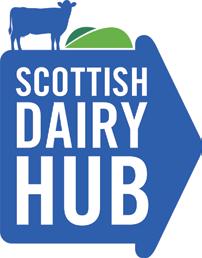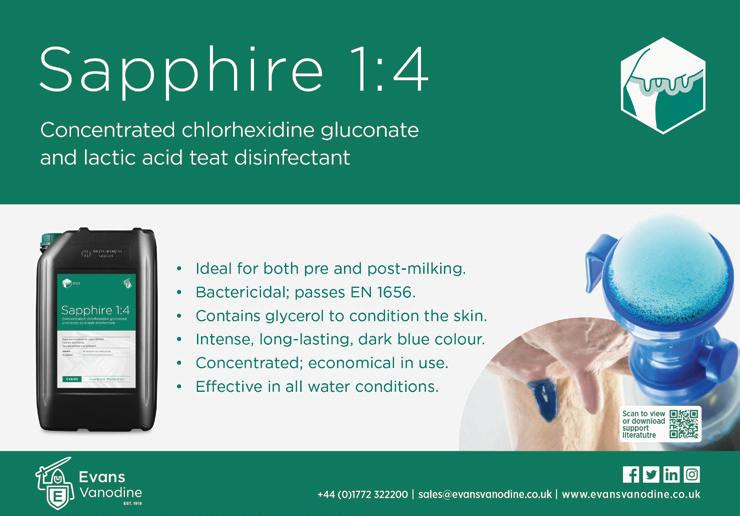
5 minute read
Scottish Dairy Hub
AgriScot dairy hub seminar plans revealed
By Stuart Martin, Scottish Dairy Hub Manager
Advertisement
The Scottish Dairy Hub and Kite Consulting are running their popular question and answer seminar at AgriScot, Ingliston, Edinburgh on 16th November 2022.
After a year’s absence, Becki Leach, Senior Consultant at Kite will be co-chairing this year’s debate with Stuart Martin, Manager of the Scottish Dairy Hub.
The Scottish Dairy Hub and Kite will deliver an expert panel to discuss the issues of the day. Both organisations have joined forces again to put on a single event which will ensure key speakers will give an insight to the short and long-term outlook, opportunities, and challenges for Scottish dairy farmers. As in previous years, there will be an opportunity for dairy farmers and stakeholders to bring along their probing questions for the panel and listen to the latest market intel.
This year’s panel includes, Paul Savage UK Director of UK Agricultural Team Member at Arla Foods. Sarah Simpson, Farm Director, Agri-Policy Specialist, and journalist & market analyst Chris Walkland. The panel has a wealth of experience on dairy issues at domestic, national, and international levels. Their knowledge and experience surrounding issues on Scottish Agriculture, Climate Change, Market Forces, and Dairy Supply Chains will ensure an insightful debate and make this a must attend event
The Scottish Dairy Hub’s key role is to answer the questions of dairy farmers and we want to give them an opportunity to ask questions directly to industry figures they may hear about but may not have a direct line for. Collaborating again with Kite will ensure a highly informative event for all that attend.
To ensure you have your questions put to the panel please email your thoughts to info@scottishdairyhub. org.uk in advance of the event. Mark your email Agriscot 2022.
Becki is senior consultant at Kite who work across the dairy supply chain with farmers, processors, retailers, and allied industry she adds:
“There are some prominent issues on the horizon for dairy farmers in Scotland and this is a fantastic opportunity to understand and discuss these with an expert panel”
The event will run upstairs in seminar Room 1 (above main entrance), Highland Hall, Ingliston, at AgriScot from 1.00pm – 2.00pm and is free to attend. After the event, the audience are encouraged to have further discussions with both Becki and Stuart on the Kite exhibition stand in the main hall.
The SCOTTISH DAIRY HUB offers dairy farmers and service providers a free signposting service connecting the dairy sector throughout Scotland. Visit our website to view all the latest information on our noticeboard and events page
www.scottishdairyhub.org.uk Tel: 03454 755110 Mob: 07500 766083 Email: lnfo@scottishdairyhub.org.uk
over 25 per cent of Scotland’s beef. We see real opportunities that we can provide, in producing a climate friendly solution to what the supply chain requires.”
Dumfries and Galloway based consultant, Lorna Galloway, told farmers that with the changes coming in agricultural policy: carbon audits, soil sampling, and nutrient management plans will soon become part of routine compliance with regulations.
“My advice to you is to get ahead of the curve and get to grips with the information you are going to be gathering before we are in a position where it is compulsory,” she said.
For any further information on the event or for advice for your dairy operation, please contact Dairy Consultant Lorna MacPherson on lorna. macpherson@sac.co.uk or 07760 990901.
Silage Quality Warning
Dairy farmers should brace themselves for ‘the perfect storm’ when it comes to silage quality this winter, with second cut results flagging palatability and digestibility issues.
Although the results were hugely variable in terms of quality, averages highlighted issues with fermentation and fibre levels, despite generally adequate protein and energy levels.
Mole Valley Farmers’ Senior Nutritionist Dr Robin Hawkey said figures to the end of August showed silages, on average, were high in fibre with an average digestibility (D) value of 67.2.
Results also showed a lactic acid to Volatile Fatty Acid (VFA) ratio of 2:1, with the ideal being 5:1. This could make silages prone to heating and secondary fermentation, causing palatability issues.
To help the situation, Dr Hawkey urged farmers growing maize to harvest it in a timely manner to avoid adding to the problem with high fibre maize. He also suggested managing feed ingredients carefully to ensure the rumen bugs remained in optimum condition and could make the most out of the silage.
“Live yeast cultures can help make the rumen fire on all cylinders,” he said. “If you have done a silage analysis and results show a dry matter (DM) in excess of 35-40% and a ratio of lactate to VFA of less than three, silage face management and moving across it quickly will be critical. The face will spoil quicker if the fermentation is not as good,” he added.
Forage stocks are also of increasing concern. Dr Hawkey said farmers should speak to their nutritionist to discuss forage-extending products, or alternatively call the team today on 01566 780261.
dairy Dairy profits rise, but cash is king, warns Old Mill
Dairy farm profits doubled in the milk year to 2021/22 and are set to continue improving this year – although soaring input costs remain a concern to all producers.
Farm accountant Old Mill unveiled its annual milk cost of production report at the Dairy Show on 5 October. It shows that average comparable farm profits among its clients* increased to £371/cow in the year to 31 March 2022, driven by a combination of slightly firmer milk prices and lower production costs.
“The year ending 31 March 2022 seems a long time ago,” says Dan Heal, rural accountant at Old Mill. “There have been a lot of changes since then, but from these times of market volatility taking a reflective look at business performance has never been more critical.”
Milk income in 2021/22 increased by £80/cow, year-onyear, with modest price increases offset by lower yields, driven by a desire to reduce production costs. “Good forage growing conditions meant a plentiful supply of high quality forage, leading to lower concentrate feed rates,” says Mr Heal. “The grazing season lasted well into the autumn, shortening the winter housing period. As a result, variable costs related to labour, bedding, power and machinery all fell.”
Even so, there remained a marked difference between the top and bottom 10% of producers, with the gap widening by £137 to £1,234/cow. Of this, £541 related to income; although top 10% yields were 1,334 litres/cow lower, income was higher. Production costs were £693/cow lower among the top 10%, mainly attributed to feed, labour, power and machinery. “There is a high focus on efficiency for the top 10% of herds. In contrast, more work is being done in a less efficient manner among the bottom 10%, which is not generating a return.” However, much of this could be attributed to less efficient setups, likely requiring investment to change.











